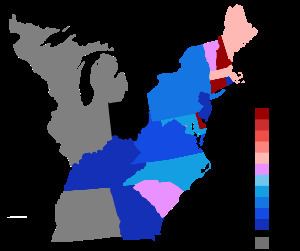April 29, 1800 - August 1, 1801 1802 → 68 38 Start date 1800 | 46 seats 60 seats 22 22 | |
 | ||
Winner Nathaniel Macon | ||
Elections to the United States House of Representatives for the 7th Congress in 1800 and 1801, at the same time as the 1800 presidential election, in which Vice President Thomas Jefferson, a Democratic Republican, defeated incumbent President John Adams, a Federalist.
Contents
- Connecticut
- Georgia
- Maryland
- Massachusetts
- New Hampshire
- New Jersey
- New York
- North Carolina
- Pennsylvania
- Rhode Island
- South Carolina
- Tennessee
- Vermont
- References
These elections resulted in the Democratic-Republicans picking up 22 seats from the Federalists. This brought the Democratic-Republicans a solid majority of 68 seats, whereas the Federalists were only able to secure 38. Many state legislatures also changed to Democratic-Republican control, with the result that many new Democratic-Republicans were voted into the Senate. The Federalists never again succeeded in gaining a majority of seats in the House of Representatives, and it was soon normal for them to control fewer than a third of the seats until the national Federalist party disintegrated completely in the early 1820s.
The victory of Jefferson and the Democratic-Republicans can be attributed partially to unpopular policies pursued by the Adams administration, including the Alien and Sedition Acts, which sought to curtail guarantees of freedom of speech and freedom of the press spelled out in the Bill of Rights.
The difference between Federalist policies in support of a strong national government and the Democratic-Republican preference for states' rights played a prominent role in the election. Federal taxation became an issue as Southerners and Westerners rejected federal taxes levied on property.
Connecticut
William Edmond (F) and Elizur Goodrich (F) both declined to serve another term and were replaced by Calvin Goddard (F) and Benjamin Talmadge (F)
Georgia
James Jones (DR) died on January 11, 1801, and was replaced in a special election by John Milledge (DR)
Milledge subsequently resigned in 1802 upon being elected Governor of Georgia and was replaced by Peter Early. Benjamin Taliaferro (DR) also resigned in 1802 to be replaced by David Meriwether (DR)
Maryland
Richard Sprigg, Jr. (DR) of the 2nd district resigned February 11, 1802, and was replaced in a special election by Walter Bowie (DR)
Massachusetts
Massachusetts' electoral law required a majority for election, which was not met in the 1st and 6th districts, necessitating a second trial.
In the 14th district, George Thatcher (F) declined to serve in the 8th Congress. A special election was held to fill the resulting vacancy, which was won by Richard Cutts (DR). At the time Thatcher left office, he was the last member of the House to have served continuously from the 1st Congress.
In the 4th district, Levi Lincoln Sr. (DR) resigned upon being appointed United States Attorney General March 5, 1801, and was replaced in a special election by Seth Hastings (F).
In the 12th district, Silas Lee (F) resigned August 20, 1801, and was replaced in a special election by Samuel Thatcher (DR)
New Hampshire
Joseph Peirce (F) resigned in 1802, and a special election was held to fill the resulting vacancy, won by Samuel Hunt
New Jersey
In 1800, New Jersey returned to its traditional at-large district, continued to use this system to select representatives until it was abolished in 1842, with a single exception in 1813.
New York
There were three vacancies during the 7th Congress. The first was in the 6th district when John Bird (F) resigned on July 25, 1801. A special election was held to fill the resulting vacancy, electing John P. Van Ness (DR). The second occurred in the 5th district when Thomas Tillotson (DR) was appointed Secretary of State of New York and resigned his seat August 10, 1801. A special election was held to fill the resulting vacancy, resulting in Theodorus Bailey (DR) taking the seat back. The third and last vacancy occurred in the 6th district when Thomas Jefferson named John P. Van Ness (DR) as a major in the militia of the Territory of Columbia. His seat was declared vacant January 17, 1801, and was left unfilled for the remainder of the 7th Congress.
North Carolina
Two vacancies occurred during the 7th Congress, both in the 8th district. The first occurred before the meeting of the Congress when David Stone (F) was elected to the Senate and was won by Charles Johnson (DR) The second vacancy occurred when Johnson died on July 23, 1802, the resulting vacancy was won by Thomas Wynns (DR).
Pennsylvania
Peter Muhlenberg (DR) of the 4th district was elected to the Senate before the start of the 7th Congress and was replaced in a special election by Isaac Van Horne (DR)
Albert Gallatin (DR) of the 12th district was appointed Secretary of the Treasury in May 1801, and was replaced in a special election by William Hoge (DR)
Rhode Island
In 1800, Rhode Island switched to a general ticket for its two seats, instead of electing each one separately. Only one candidate received a majority, requiring a run-off election to choose a Representative for the second seat.
South Carolina
In the 4th district, Thomas Sumter (DR) resigned on December 15, 1801, upon being elected to the Senate. A special election was held to fill the vacancy, which elected Richard Winn (DR)
Tennessee
Claiborne did not serve in the 7th Congress as he was appointed Governor of Mississippi Territory and was replaced in a special election by William Dickson (DR)
Vermont
Vermont electoral law required a candidate to win a majority to take office, necessitating a run-off election in the 2nd (Eastern) district.
